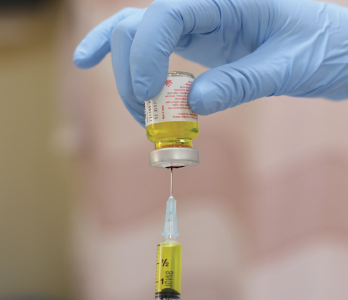
Li Wa / shutterstock.com
CHICAGO—Once methotrexate enters a cell through the reduced folate carrier (RFC), which thinks it is picking up folate, the drug is polyglutamated. It is this polyglutamate methotrexate that provides the actual clinical effect. These methotrexate polyglutamate “species” are added and lost over time, but it’s a slow process.
What difference does it make whether a clinician knows this? An understanding of the process makes it more likely a clinician will make sound decisions for their patients, said Joel Kremer, MD, the Pfaff Family Professor of Medicine at Albany Medical College, N.Y., and director of research at The Center for Rheumatology, during the 2018 ACR/ARHP Annual Meeting. He has devoted much of his career to studying methotrexate in patients with rheumatoid arthritis. His back-to-basics talk on the cornerstone drug touched on different modes of methotrexate administration, drug resistance and toxicity.
With methotrexate polyglutamate, the underlying science means rapid dosing escalation is probably not the best approach. “Understanding the complexities of the differential cellular sensitivities to methotrexate can, and should, inform our approach to management,” Dr. Kremer said. “Clinical decisions should be anchored with an understanding of the biochemistry and metabolism of this unique drug.”
Researchers have shown it takes a median of 27.5 weeks for methotrexate polyglutamate species to reach a steady state concentration. In other words, Dr. Kremer said, “don’t expect instant results when the dose of methotrexate is changed.”1
“If you choose to increase the dose every two weeks, I can see it as a pragmatic maneuver to get you to the point where you believe your patient will have sufficient methotrexate to do the job,” he said. “But you will not be able to judge the actual clinical result of the increase in a two-week period. There’s simply not enough time for the accumulation of the polyglutamates.”
‘Don’t expect instant results when the dose of methotrexate is changed.’ —Dr. Kremer
More Methotrexate Insights
Dr. Kremer offered six additional insights that hold important clinical ramifications:
- Oral vs. subcutaneous: Oral absorption of methotrexate, he said, is highly variable. It could drop by as much as 30% when the dose increases from 7 mg to 15 mg or more. Switching to parenteral administration, then, can improve bioavailability dramatically.2
- Methotrexate resistance: Rapidly dividing cells take in methotrexate more readily, but the decreased cellular activity from treatment decreases the drug’s uptake. “Thus, long term, clinically effective methotrexate could lead to a diminution of its own uptake and a plateau of response,” Dr. Kremer said.
- Folate and methotrexate efficacy: Although methotrexate is a folate antagonist, taking folate with methotrexate should not be a concern, he said. There is some evidence that in matched populations, those not taking folate need less methotrexate than those taking folate, but the effect is not enough to discourage the use of folate.3 “Withholding folate supplementation with methotrexate is a mistake. There is no reason I can find in the world’s literature to withhold folate supplementation on the day of methotrexate. Folic acid does not enter the cell via the RFC,” so there is no competition for uptake, he said.
- Combinations: Although hydroxychloroquine increases the active tubular resorption of methotrexate, sulfasalazine competes for cellular uptake with methotrexate at the RFC, so it could result in a lower therapeutic effect for methotrexate. The combination of methotrexate and sulfasalazine has proved inferior to methotrexate and hydroxychloroquine, Dr. Kremer said. Interestingly, triple therapy with all three has proved more effective than either of the aforementioned doublet combinations, he said.
- Toxicity: The duration of exposure of rapidly dividing cells to methotrexate will determine whether they become toxic, and any exposure to a serum level of methotrexate of more than 0.05 umol/L for more than 24 hours will result in a cytotoxic effect. Also, any compromise in renal function prolonging the terminal half-life of the drug beyond 24 hours at that level will result in toxicity to rapidly dividing cells in the gut, oral mucosa and bone marrow. Giving methotrexate to patients with renal insufficiency must be done carefully, he said.
- Alcohol consumption and liver monitoring: Dr. Kremer said some patients can tolerate regular alcohol methotrexate for the long term, but other, more sensitive patients will develop irreversible liver fibrosis or cirrhosis. You can’t tell one group from the other, he said, so it’s important not to ignore any elevations of transaminase enzymes or decreases of serum albumin if the levels are sustained on repeat testing. “Any elevations of transaminase enzymes, if persistent,” he said, “should trigger a decrease of the weekly dose until the elevations disappear.”
Thomas R. Collins is a freelance writer living in South Florida.
References
- Dalrymple JM, Stamp LK, O’Donnell JL, et al. Pharmacokinetics of oral methotrexate in patients with rheumatoid arthritis. Arthritis Rheum. 2008 Nov;58(11):3299–3308.
- Braun J, Kästner P, Flaxenberg P, et al. Comparison of the clinical efficacy and safety of subcutaneous versus oral administration of methotrexate in patients with active rheumatoid arthritis: Results of a six-month, multicenter, randomized, double-blind, controlled, phase IV trial. Arthritis Rheum. 2008 Jan;58(1):73–81.
- Khanna D, Park GS, Paulus HE, et al. Reduction of the efficacy of methotrexate by the use of folic acid: Post hoc analysis from two randomized controlled studies. Arthritis Rheum. 2005 Oct;52(10):3030–3038.
